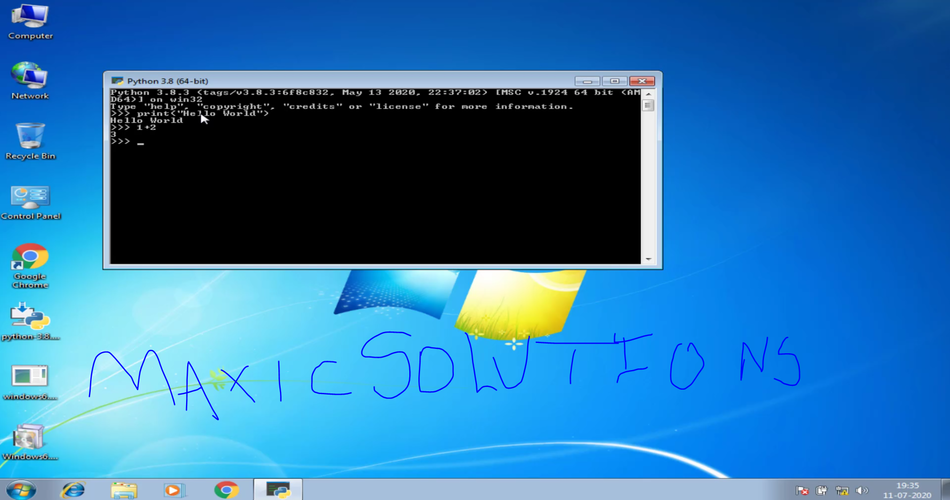

- #RUN PYTHON SCRIPT MAC HOW TO#
- #RUN PYTHON SCRIPT MAC CODE#
- #RUN PYTHON SCRIPT MAC TV#
- #RUN PYTHON SCRIPT MAC WINDOWS#
Because Windows machines ignore this line and Unix-based systems such as macOS use it, including the line makes the script transferable among the different types of computers.
#RUN PYTHON SCRIPT MAC CODE#
However, Unix computers use the line to find the version of Python to use to execute the code in the file. The # precedes a single-line comment, so the line of code isn’t read or executed on a Windows computer. Notice that the first character is the pound or hash character ( #). The first line is a special line called the shebang, which you should always include as the very first line in your Python scripts. Write the following two lines of code in the text file: #!/usr/bin/env python3 print ( "Output #1: I'm excited to learn Python." ) I hope this article helps you understand what the Python shell is and how you can use it in your day to day lives.Open the Spyder IDE or a text editor (e.g., Notepad, Notepad++, or Sublime Text on Windows TextMate, TextWrangler, or Sublime Text on macOS).
#RUN PYTHON SCRIPT MAC HOW TO#
We also saw how to run Python scripts from the command line. In this article, we learnt about the shell, terminal, how to use the Python shell. Then you execute them from the terminal using the Python command.Īll the commands we executed previously via the shell, we can also write it in a script and run in this way. py extension, typically called Python scripts.

The Python shell is useful for executing simple programs or for debugging parts of complex programs.īut really large Python programs with a lot of complexity are written in files with a. Here you can see that Numpy has 606 methods and properties in total. You can see what methods and attributes a module offers by using the dir() method: > You can inspect Python modules from the shell, as shown below: > ) of the Python shell here.įinally to invoke the function from the shell, you simply call the function the way you would do in a script: > weekend_party(watch_list) Next, let's define a function that accepts a list of shows and randomly returns a show: > def weekend_party(show_list):
#RUN PYTHON SCRIPT MAC TV#
Here we defined a list with some TV show names via the Python shell. characters which signifies that a line continues. If you have commands that span across several lines – for example when you define loops – the shell prints the. The > is the shell prompt where you type in your commands.

You can do pretty much everything that the Python language allows, from using variables, loops, and conditions to defining functions and more. you can hit Ctrl+Z on Windows or Ctrl+D on Unix systems to quitĬ:\Users\Suchandra Datta> C:\Users\Suchandra Datta>pythonĬ:\Users\Suchandra Datta> What Can You Do in the Python Shell?.There are different ways to quit the shell:

It'll read each command, evaluate and execute it, print the output for that command if any, and continue this same process repeatedly until you quit the shell. The interactive shell is also called REPL which stands for read, evaluate, print, loop. Type "help", "copyright", "credits" or "license" for more information. To start the Python shell, simply type python and hit Enter in the terminal: C:\Users\Suchandra Datta>python You can get a lot of detailed information regarding the Python shell in the official docs. The Python Shell gives you a command line interface you can use to specify commands directly to the Python interpreter in an interactive manner. This means that the Python interpreter reads a line of code, executes that line, then repeats this process if there are no errors. To access the terminal on Ubuntu, hit Ctrl + Alt + T. To access the terminal on Windows, hit the Windows logo + R, type cmd, and press Enter. This is why it's also called the command line. The terminal is the program that interacts with the shell and allows us to communicate with it via text-based commands. The shell is also called the command processor. Shell is another program, whose job is to take input and decide and execute the required kernel program to do the job and show the output. Kernel programs are the ones who perform the actual tasks, like creating a file or sending interrupts. Operating system programs are of two types, called shell and kernel programs. They perform tasks like file handling, memory management, and resource management, and they help your applications run smoothly.Īll the work we do on computers, like analyzing data in Excel or playing games, is facilitated by the operating system. What is a Shell?Īn operating system is made up of a bunch of programs. There are two ways of doing it: using the Python shell or writing it as a script and running it in the terminal. When you're starting out learning a new programming language, your very first program is likely to be one that prints "hello world!".


 0 kommentar(er)
0 kommentar(er)
